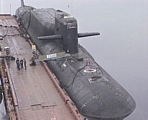Nuclear Weapons Reassert Russian Might, Sort Of
 A new review of Russian nuclear forces published in the Bulletin of the Atomic Scientists says that the Kremlin appears to be attempting to reassert its nuclear strength after years of decline in order to underscore Russia’s status as a powerful nation. Large-scale exercises have been reinstated and modernizations of nuclear forces continue with reports about a new maneuverable warhead and the mobile version of the SS-27 (Topol-M) expected to become operational later this year.
A new review of Russian nuclear forces published in the Bulletin of the Atomic Scientists says that the Kremlin appears to be attempting to reassert its nuclear strength after years of decline in order to underscore Russia’s status as a powerful nation. Large-scale exercises have been reinstated and modernizations of nuclear forces continue with reports about a new maneuverable warhead and the mobile version of the SS-27 (Topol-M) expected to become operational later this year.
Yet the reassertion is done with fewer strategic warheads than at any time since the mid-1970s, approximately 3,500 operational strategic warheads. The number of operational non-strategic nuclear weapons has been cut by more than half to approximately 2,300 warheads.
Moreover, during 2005, Russia’s 12 nuclear ballistic missile submarines only conducted three deterrent patrols. This is a slightly better performance than in 2002 when no patrols were made, but a far cry from the 1980s when Soviet ballistic missile submarines conducted 50-100 deterrent patrols each year.
Article: Russian Nuclear Forces, 2006
Background: Russian Submarine Patrols
Satellite imagery has long served as a tool for observing on-the-ground activity worldwide, and offers especially valuable insights into the operation, development, and physical features related to nuclear technology.
This report outlines a framework relying on “Cooperative Technical Means” for effective arms control verification based on remote sensing, avoiding on-site inspections but maintaining a level of transparency that allows for immediate detection of changes in nuclear posture or a significant build-up above agreed limits.
The grant comes from the Carnegie Corporation of New York (CCNY) to investigate, alongside The British American Security Information Council (BASIC), the associated impact on nuclear stability.
Satellite imagery of RAF Lakenheath reveals new construction of a security perimeter around ten protective aircraft shelters in the designated nuclear area, the latest measure in a series of upgrades as the base prepares for the ability to store U.S. nuclear weapons.